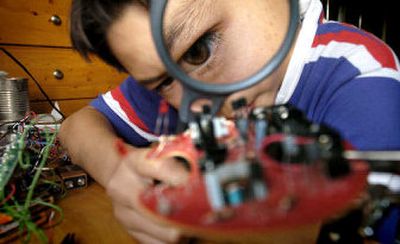Back to the books

SAN FRANCISCO — Alex Lam-Niemeyer could care less that Google can churn up millions of Web pages when he’s researching homework assignments. Typically, he researches his reports by scouring library stacks, just as students have done for generations.
“There’s too much stuff on the Internet,” said the 12-year-old middle schooler in Berkeley, Calif. “I did this one search and it came back with 2 million pages. It takes too long to find what you’re looking for.”
Against a backdrop of talking dictionaries, computerized pens, and cell phones that issue pop quizzes, parents are being promised that the latest whiz-bang gadgetry can boost their children’s grade-point average and keep them from falling behind their peers.
But Alex’s perspective — shared by many educational technology analysts — is that many of these big-bucks digital tools won’t give the haves an advantage over classroom have-nots.
“The biggest problem that students have is that technology often ends up being a distraction,” says Robin Raskin, the founder and former editor of FamilyPC magazine. “In an information society the smart person will be the one who can shut out all the distractions.”
Raskin cites an example of a student who searches the Web for information on the French Revolution — and comes up with french toast, french music or french kissing. “A child can spend half the night searching for an answer to one question,” Raskin said.
The Internet age has ushered in some valuable digital learning tools, some educational experts say. But parents must be choosy to find truly useful software programs, handheld devices or educational Web sites.
Parents should consider whether a product really addresses a child’s weaknesses and strengths, and be sure the software is compatible with their computer, says Warren Buckleitner, editor of Children’s Technology Review.
They should also take advantage of older software packages, which can be found at Web sites such as Planetcdrom.com, eBay.com and Kidsclick.com, and cost far less than current off-the-shelf products, he said.
For students wrestling with algebra, geometry or calculus, Stanford University education professor Roy Pea recommends Geometer’s Sketchpad, produced by Emeryville, Calif.-based Key Curriculum Press. Introduced 15 years ago, the $39.95 Sketchpad allows students to construct objects on a computer screen and then explore their mathematical properties by dragging points on the object with a mouse.
Mindful that many school administrators have tried to ban cell phones because teenagers use them to play games, chat and share answers to tests in the classroom, some companies are creating software that can make the devices more than tools for entertainment and cheating.
San Diego-based Vocel loads study material and sample questions for the Scholastic Aptitude Test on cell phones so students can study as they wait for the bus or head to school. For $3.99 a month or a flat fee of $9.99, the phones ring with pop quizzes and timed tests. Parents can track their child’s progress at a secure Web page on Vocel.com.
Microsoft Student 2006 attempts to become a homework help destination for middle and high school students.
It combines Word, Excel, PowerPoint, Encarta Encyclopedia and a graphing calculator, summarizes major books and suggests topics for book reports. But the software, which retails for between $80 and $100, has received less than enthusiastic reviews.